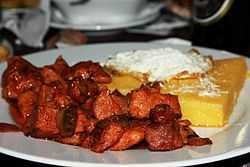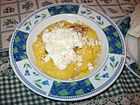Mămăligă
| Mămăligă | |
|---|---|
| Porridge | |
 | |
| Place of origin: | |
| Romania, Moldova | |
| Main ingredient(s): | |
| Yellow maize flour | |
| Recipes at Wikibooks: | |
|
| |
| Media at Wikimedia Commons: | |
|
|
| This article is part of the series |
| Romanian cuisine |
|---|
|
Soups
|
|
Appetizers & Salads
|
|
Dishes
|
|
Delicatessen
|
|
Cheeses
|
|
Breads
|
|
Desserts
|
|
|

Mămăligă (Romanian pronunciation: [məməˈliɡə]) is a porridge made out of yellow maize flour, traditional in Romania and Moldova. It is similar to the Italian polenta.[1]
History
Historically a peasant food, it was often used as a substitute for bread or even as a staple food in the poor rural areas. However, in the last decades it has emerged as an upscale dish available in the finest restaurants.
Roman influence
Historically, porridge is the oldest form of consumption of grains in the whole of humanity, long before the appearance of bread. Originally, the seeds used to prepare slurries were very diverse as millet or einkorn.
Before the introduction of maize in Europe in the 16th century, mămăligă had been made with millet flour, known to the Romans as pulmentum. Moreover, the Romans ate so much of it that the Greeks called them pultiphagonides (porridge eaters).
Corn's introduction in Romania
Maize was introduced into Spain by Hernán Cortés from Mexico and spread in Europe in the 16th century. Maize (called corn in the United States) requires a good amount of heat and humidity. The Danube Valley is one of Europe's regions ideal for growing maize.
A Hungarian scholar documented the arrival of corn in Timişoara, Banat region, 1692.[2] In Transylvania, maize is also called 'cucuruz',[3] which could imply a connection between Transylvanian and Serbian merchants, kukuruz being a Slavic word.[4] Some assume it was either Şerban Cantacuzino[5][6] or Constantin Mavrocordat[7] who introduced corn in Wallachia, Maria Theresa in Transylvania[8] and Constantine Ducas in Moldova[9] where it is called păpuşoi.[10] Mămăligă of millet would have been replaced gradually by mămăligă made of corn. The corn then become an important food, especially in the fight against famine which prevailed in the 17th and 18th centuries.[11]
Historian Nicolae Iorga noted that farmers of the Principality of Romania grew corn since the early-to-mid-17th century.[12]
Etienne Ignace Raicevich, a Ragusan and consul of the Empire in Bucharest in the third quarter of the 18th century, wrote that corn was introduced only da poco tempo.
The existence of corn-based mămăligă is attested since 1873 in the edition of Larousse, a French dictionnary: mamaliga s. f. Boiled corn meal, in the Danubian principalities.
Preparation


Traditionally, mămăliga is cooked by boiling water, salt and cornmeal in a special-shaped cast iron pot called ceaun or tuci. When cooked peasant-style and used as a bread substitute, mămăliga is supposed to be much thicker than the regular Italian polenta to the point that it can be cut in slices, like bread. When cooked for other purposes, mămăligă can be much softer, sometimes almost to the consistency of porridge. Because mămăligă sticks to metal surfaces, a piece of sewing thread can be used to cut it into slices instead of a knife; it can then be eaten by holding it with the hand, just like bread.
Mămăligă is often served with sour cream and cheese on the side (mămăligă cu brânză şi smântână) or crushed in a bowl of hot milk (mămăligă cu lapte). Sometimes slices of mămăligă are pan-fried in oil or in lard, the result being a sort of corn pone.
Since mămăliga can be used as an alternate for bread in many Romanian and Moldovan dishes, there are quite a few which are either based on mămăligă, or include it as an ingredient or side dish. Arguably, the most popular of them is sarmale (a type of cabbage roll with mămăligă.
Another very popular Romanian dish based on mămăligă is called bulz, and consists of mămăligă with cheese and butter and roasted in the oven.

Balmoş (sometimes spelled balmuş) is another mămăligă-like traditional Romanian dish, but is more elaborate. Unlike mămăligă (where the cornmeal is boiled in water) when making balmoş the cornmeal must be boiled in sheep milk. Other ingredients, such as butter, sour cream, telemea (a type of feta cheese), caş (a type of fresh curdled ewe cheese without whey, which is sometimes called "green cheese" in English), urdă (a type of curdled cheese obtained by boiling and curdling the whey left from caş), etc., are added to the mixture at certain times during the cooking process. It is a specialty dish of old Romanian shepherds, and nowadays very few people still know how to make a proper balmoş.
Mămăliga is a versatile food: various recipes of mămăligă-based dishes may include milk, butter, various types of cheese, eggs, sausages (usually fried, grilled or oven-roasted), bacon, mushrooms, ham, fish etc. Mămăliga is a fat-free, cholesterol-free, high-fiber food. It can be used as a healthy alternative to more refined carbohydrates such as white bread, pasta or hulled rice.
Trivia
- A gruel made of cornmeal, water, milk, butter, salt and sugar is called in Romanian cir de mămăligă. If it is exceedingly thin and made only of cornmeal, water and salt it is called mieşniţă or terci.
- Depending on the context, mălai is the Romanian word for either:
- Corn flour (i.e., maize flour) is called in Romanian mălai or făină de mălai.
- Before the arrival of maize in Eastern Europe, mămăliga was made of millet flour, but nowadays millet mămăligă is no longer made.
Mămăligă in literature
In Dracula by Bram Stoker, in chapter 1 it's written: "I had for breakfast more paprika, and a sort of porridge of maize flour which they said was 'mamaliga', and egg-plant stuffed with forcemeat, a very excellent dish, which they call 'impletata'."
Similar dishes
Its analogue in Serbia and Bulgaria is called kachamak (Serbian: качамак/kačamak), (Bulgarian: качамак) and is served mainly with white brine cheese or fried pieces of pork fat with parts of the skin.
In Bosnia and Herzegovina, Croatia (also "polenta" or "palenta"), Serbia (also "kačamak) and in Montenegro the dish is mainly called "pura". In Macedonia it is called "bakrdan" and in Slovenia "polenta". In Turkey a similar dish, called kuymak or muhlama is among the typical dishes of the Black Sea Region, although now popular in all the greater cities where there are many regional restaurants.
There is also a distinct similarity to Fungi (Antigua, Barbuda, and other LeeWard islands in the Caribbean Sea and CouCou form Barbados also in the Caribbean Sea.[13]
Photo gallery, mămăligă based dishes
-

-

-

-

-

-

-

-

-

-

-

-
-

-
A plate of mămăligă with smetana and bacon
-

See also
References
- ↑ "Coming up: Food from the new EU". BBC News. January 1, 2007. Retrieved 30 October 2013.
- ↑ (French) "Le maïs arrive dans les Balkans". Georges C. Haupt.
- ↑ example (Romanian) http://www.hotnews.ro/stiri-esential-2404258-maghiarii-din-ardeal-indiferenti-kosovo-sadim-cucuruz-vin-mistretii-mananca-no-asta-problema-noastra.htm
- ↑ (Romanian) http://www.archeus.ro/lingvistica/CautareDex?query=CUCURUZ
- ↑ (English) http://www.ongo.com/v/1346764/-1/6AF4EB7DB81AB64D/romanian-prince-actor-serban-cantacuzino-70
- ↑ (Romanian) http://ro.wikisource.org/wiki/Din_trecutul_nostru:Țările_române_în_veacul_al_XVII-lea
- ↑ (Romanian) http://www.free-referate.ro/referat-Introducerea-porumbului-in-agricultura-3199.html
- ↑ (Romanian) http://www.scribd.com/doc/50632250/66/Sistematică-Origine-Hibrizi-cultivaţi-in-Romania
- ↑ (Romanian) http://www.free-referate.ro/referat-Introducerea-porumbului-in-agricultura-3199.html
- ↑ (Romanian) http://dexonline.ro/definitie/p%C4%83pu%C8%99oi/28932
- ↑ (French) "L'introduction des plantes du Nouveau Monde dans les cuisines régionales". Philippe Marchenay, Jacques Barrau, Laurence Bérard.
- ↑ (French) "L'introduction des plantes du Nouveau Monde dans les cuisines régionales". Philippe Marchenay, Jacques Barrau, Laurence Bérard.
- ↑ Personal Experience as an Antiguan national.
External links
-
 Media related to Mămăligă at Wikimedia Commons
Media related to Mămăligă at Wikimedia Commons

